No. 46 - End of Push-broom Operations
Flight Dynamics has completed the first analysis of the Smart-1 impact on the Moon in 2006 and the different options. The current prediction estimates the impact on the Moon in August 2006.
The final implementation of Space Link Extended services (SLE) with the DLR station of Weilheim (Germany) has been very successful. The end to end tests after the SLE configuration lasted less than a week demonstrating the great potential of this interface for cross support between different organisations. Weilheim will be used to complement the existing ESA network used as part of the European Network of Centers cooperation program.
SMART-1 has also been approached by the Indian ISRO and the Chinese CLTC as a tracking target for orbit determination as preparation for their missions to the Moon: Chandrayaan-1 (ISRO, India) and Chang'E 1 orbiter (CNSA, China). These tracking campaigns will be part of the activities in 2006.
Future Activities
Future activities are focused on the following:
- Measurement the Weilheim ground station delays as last step before starting using the station operationally
- Continue the work for the ground automation activities. Parallel testing with real time telemetry
- Preparation of the Week of the Moon show in ESOC
- End of mission preparation and impact of the Moon selection
Spacecraft Status
AOCS
The AOC subsystem has done well in the period covered by this report.
The only special event during the reporting period was the last period of push broom operations for AMIE which implied an illumination of the +Y face of the S/C with high incident angles from 8 December onwards. This resulted in higher peak temperatures for CHU2 reaching values of 39.5 °C. Push broom operations have been limited to operations in the south hemisphere from 90 deg South to 90 deg North in the day side in order to have only one ST CHU hot. Push broom operation is defined as a flight direction where the groundtrack velocity vector is along the AMIE CCD axis.
In addition, due to high Sun incident angle in the +Y face of the S/C CHU2 was sometimes blinded by the Sun during the last days of push broom operations.
Orbital Information
|
SMART-1 OD388 Close to Apolune 1655 Elements WRT Moon and its equator of date | |
| Pericentre Distance (km) | 2375.454673 |
| Apocentre Distance (km) | 4460.454870 |
| Semi Major Axis (km) | 3417.954771 |
| Eccentricity | 0.305007 |
| Inclination (°) | 90.113799 |
| Ascending Node (°) | 238.296951 |
| Argument of Pericentre (°) | 269.910707 |
| True Anomaly (°) | 180.000030 |
| Osculating Orbital Period (h) | 4.980864 |
The changes since apolune 1621 as follows:
- semi-major axis +0.4 km
- perilune height +10.5 km
- apolune height -9.6 km
- orbital period +0.1 min
Future Orbit Calculations
Experts at ESOC have been computing the final mission scenario for SMART-1 and the determination of the data for lunar impact. On 15 December 2005 the state of the spacecraft was as follows:
- Radius of perilune = 2372 km (moon radius = 1738 km)
- Radius of apolune = 4463 km
- Coordinate system:
- Z-axis towards moon north pole of date
X-axis towards descending node of earth equator of epoch 2000 w.r.t. moon equator of date - Inclination = 90.4 deg
- Right ascension of ascending node = 238.2°
- Argument of perilune = 270.7°
- Xenon left = 0.260 kg (0.060 kg usable with special operations => 1.6 m/s)
- Hydrazine left = 6.5 kg
The following diagrams show how a number of parameters will vary between now and the end of the mission.
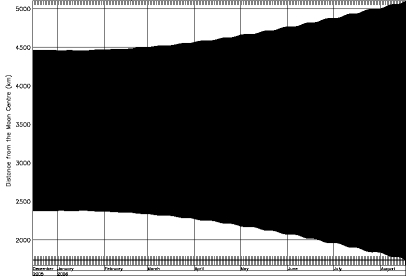 |
|
Distance from centre of Moon |
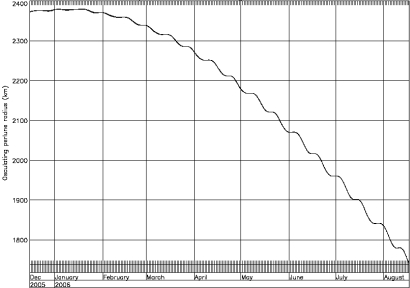 |
|
Osculating Perilune Radius |
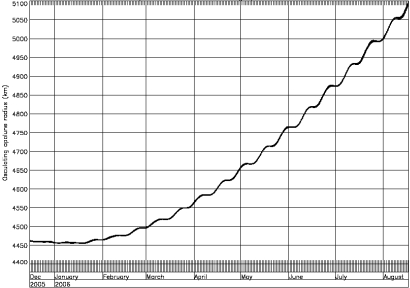 |
|
Osculating Apolune Radius |
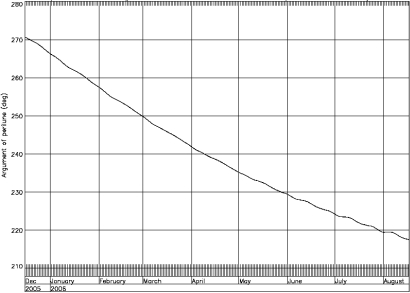 |
|
Argument of Perilune |
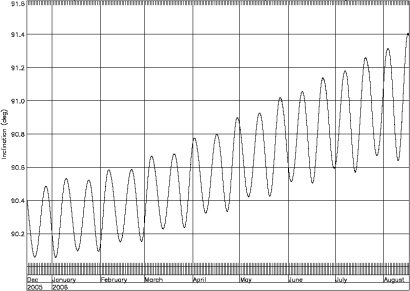 |
|
Inclination |
Perilune of 300 km
- Date = 2006/06/10 ~19:30
- Radius of perilune = 2038 km
- Radius of apolune = 4797 km
- Coordinate system:
- Z-axis towards moon north pole of date
X-axis towards descending node of earth equator of epoch 2000 w.r.t. Moon equator of date - Inclination = 91.0°
- Right ascension of ascending node = 239.6°
- Argument of perilune = 227.8°
- Sun-moon-perilune angle = 52.7°
Perilune of 0 km
- Date = 2006/08/17 ~11:00 (uncertainty ~ 1 day)
- Radius of perilune = 1738 km
- Radius of apolune = 5096 km
- Inclination = 91.4°
- Right ascension of ascending node = 239.7°
- Argument of perilune = 217.5°
- Sun-moon-perilune angle = 87.0°
- Earth-moon-perilune angle = 134.4°
- Longitude of perilune = 174.4°
- Latitude of perilune = -37.5°
- +X to Earth angle when +Z to velocity at perilune = 105.0°
- Velocity at perilune = 2.051 km/s
- Perilune radius change per orbit -1.888 km/rev
It should be noted that the impact date of 17 August 2006 assumes no further changes are made to the spacecraft orbit. It is possible that this date will change to accommodate specific requests to enable monitoring of the impact from Earth.

